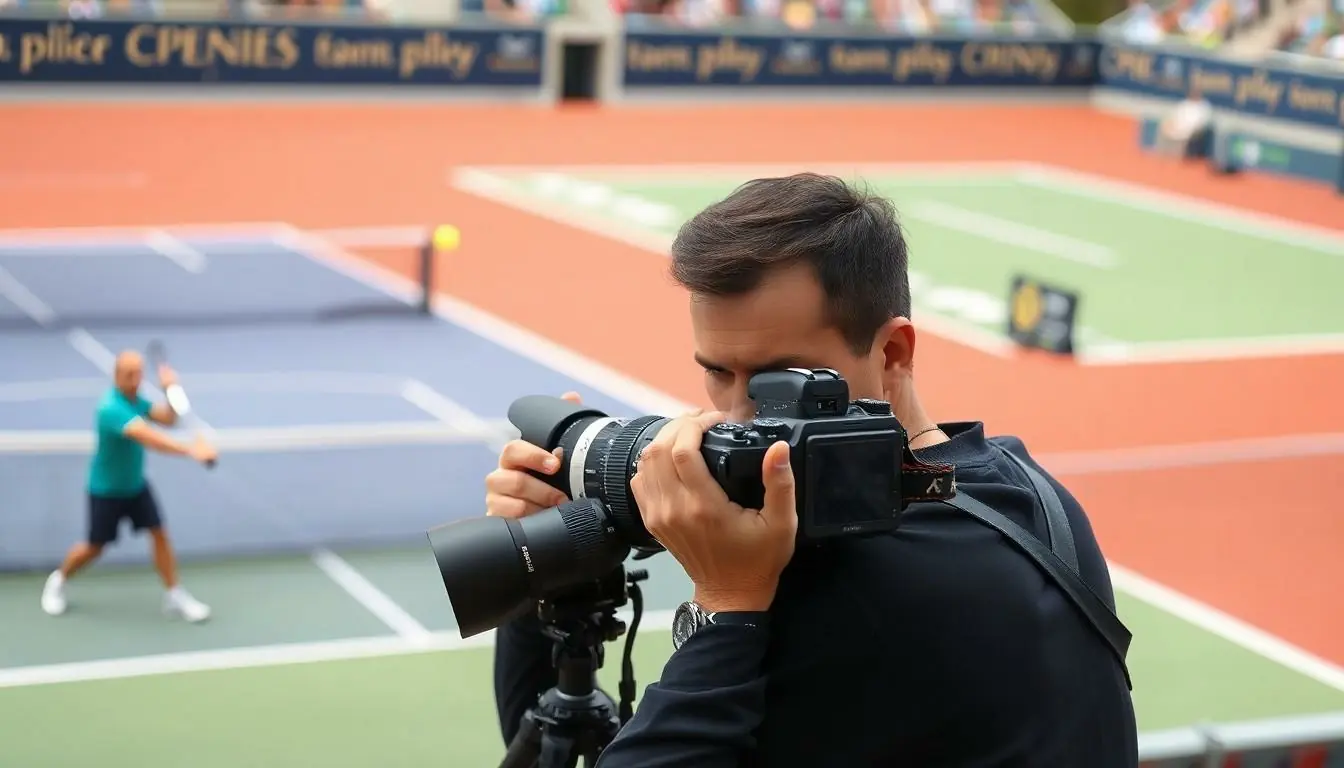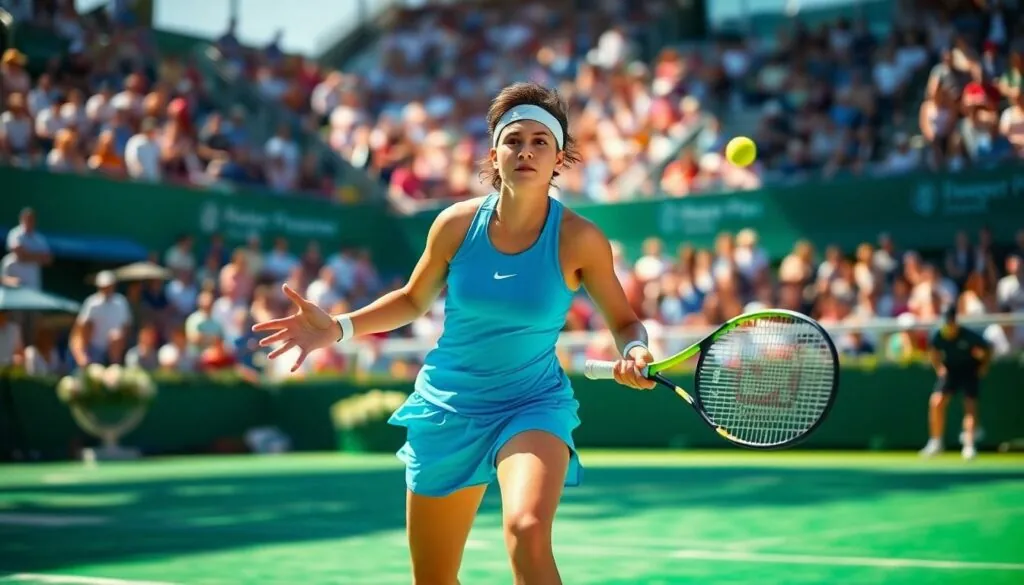Table of Contents
ToggleTennis photography isn’t just about snapping pictures of players whacking fuzzy yellow balls; it’s an art form that captures the drama, emotion, and sheer athleticism of the game. Imagine freezing that epic moment when a player serves like a rocket, or the intensity in their eyes as they dive for a ball. It’s like being a ninja with a camera, stealthily capturing the thrill of the match without disturbing the zen of the players.
Overview of Tennis Photography
Tennis photography captures dynamic moments that convey the energy and emotion of the sport. The focus lies on portraying players’ athleticism and the intensity of competition. Effective tennis photographs highlight key action shots, like a player launching into a powerful serve or executing a precise volley.
Photographers often position themselves strategically around the court to seize the best angles. Taking shots from the baseline or net provides varied perspectives on gameplay. Capturing facial expressions adds depth, revealing the concentration and determination of athletes. The right timing ensures that photographers can freeze split-second events, creating a narrative that resonates with viewers.
Lighting plays a crucial role in tennis photography. Natural daylight enhances colors and textures, making images pop. Many photographers adjust their settings to accommodate changing light conditions, preserving the quality of their work.
Equipment choice impacts the final result. Professional lenses with fast autofocus capabilities excel in capturing rapid movements. A zoom lens offers flexibility, allowing photographers to frame subjects tightly or include context from the surrounding environment.
Post-processing enhances the impact of tennis photographs. Editors can sharpen images, adjust contrast, and apply color corrections to achieve the desired aesthetic. These enhancements help refine the storytelling aspect of each image.
Tennis photography embodies the art of freezing fleeting moments in time. By skillfully combining angles, lighting, equipment, and editing, photographers convey the beauty and excitement of the match.
Equipment for Tennis Photography

Capturing the action in tennis requires the right equipment. Specific gear enhances the photographer’s ability to document the intensity of the sport.
Cameras
DSLR and mirrorless cameras excel in tennis photography due to their fast autofocus and high burst rates. These features allow photographers to freeze critical moments during matches. Full-frame sensors provide superior low-light performance, making them ideal for evening games. Popular models include the Canon EOS R5 and Nikon Z6. These cameras offer effective image stabilization, which curtails blurriness in fast-paced scenes.
Lenses
Telephoto lenses are essential for tennis photography, enabling close-up shots from a distance. A 200-400mm lens captures detailed images without interrupting the game. Prime lenses, such as 300mm f/2.8, deliver crisp images with excellent depth of field. Additionally, a good wide-angle lens can capture the entire court, putting key moments in context. Fast and responsive lenses allow for sharp image quality even in varying light conditions.
Accessories
Accessories enhance the shooting experience and improve photo quality. A sturdy tripod or monopod stabilizes long lenses, providing better focusing capabilities. Essential items like extra batteries ensure uninterrupted shooting throughout the match. Memory cards with fast write speeds prevent delays during high-action sequences. Using a lens hood reduces glare and improves contrast, ensuring images stand out vibrantly.
Techniques for Capturing Action
Capturing action in tennis photography requires skill and foresight. Timing and anticipation play a crucial role in seizing the fleeting moments of a match.
Timing and Anticipation
Understanding the rhythm of the game helps photographers anticipate pivotal moments. Observing players’ movements leads to a better sense of when to press the shutter. Spotting key actions, such as serves or volleys, can create impactful images that resonate with viewers. Photographers who remain alert pick up on subtle cues, like a player’s stance or grip on the racket, signaling an imminent shot. Practicing with different players or at various events sharpens this intuition, allowing for more compelling captures during matches.
Composition Tips
Effective composition enhances the storytelling aspect of each photograph. Positioning the subject in the frame creates a balanced image, often using the rule of thirds for dynamic results. Framing techniques, like including the net or spectators, add context and depth. Focusing on players’ expressions captures emotion while showcasing their athleticism. Adjusting perspectives, such as low angles or close-ups, enriches the visual narrative. Incorporating leading lines, like court markings, guides the viewer’s eye, emphasizing movement and action within the scene.
Post-Processing in Tennis Photography
Post-processing plays a critical role in elevating tennis photography, helping images to reflect the excitement and energy of the sport effectively. By refining pictures after the initial capture, photographers can significantly enhance their visual storytelling.
Editing Software
Many photographers rely on software like Adobe Lightroom and Photoshop. These tools provide essential features for adjusting exposure, contrast, and color balance. Using Lightroom, photographers can batch edit multiple images quickly, streamlining their workflow. Photoshop allows for more detailed manipulation, including background removal and retouching. Both options offer presets that can help maintain a consistent look across a series of images.
Enhancing Your Images
Color enhancement improves the vibrancy of images, capturing the dynamic hues of the court and players’ attire. Adjusting sharpness highlights key details, such as facial expressions and racket movements. Cropping an image strategically can create a stronger focal point, drawing attention to the players during critical moments. Additionally, applying noise reduction techniques enhances clarity, especially in images taken in low light. Fine-tuning these aspects transforms a good photograph into a striking visual narrative that captures the essence of a tennis match.
Notable Tennis Photographers
Tennis photography boasts several renowned photographers who excel in capturing the sport’s dynamic essence. Annie Leibovitz has made a significant impact with her powerful portraits, often highlighting the emotion of athletes. David Burnett, known for his unique angles, brings a fresh perspective to tennis events, focusing on both the players and the audience’s reactions.
Richard Avedon, a master of portrait photography, captured iconic images that showcase tennis legends, emphasizing their charisma both on and off the court. Jeremy Selwyn stands out for his ability to seize decisive moments during matches, providing viewers with a sense of the game’s adrenaline.
Bob Martin is celebrated for his comprehensive coverage of major tournaments, documenting not just the action but also the stories behind the players. Andrew Patron brings a creative flair to his work, often blending artistry with sports photography, resulting in visually stunning images that tell a deeper story.
Mark Garyes specializes in capturing the intensity of matches, focusing on the players’ expressions that convey their emotions in high-stakes moments. Through their distinct styles and approaches, these photographers collectively contribute to the rich visual history of tennis, allowing fans to experience the sport in captivating ways.
Their work not only showcases athletic skill but also highlights the passion and dedication of the players. Each photographer brings a unique vision to the court, emphasizing the thrill of competition and the beauty of the match.
Tennis photography captures the essence of the sport in unique ways. By blending technical skills with an artistic eye, photographers can showcase the intensity and emotion of each match. The right equipment and understanding of composition are crucial for creating stunning images that resonate with fans and players alike.
Post-processing techniques further elevate these photographs, transforming them into compelling visual stories. As seen through the work of renowned photographers, each image tells a narrative that goes beyond the court, inviting viewers to experience the thrill of competition. With practice and dedication, anyone can harness the power of tennis photography to freeze unforgettable moments in time.






